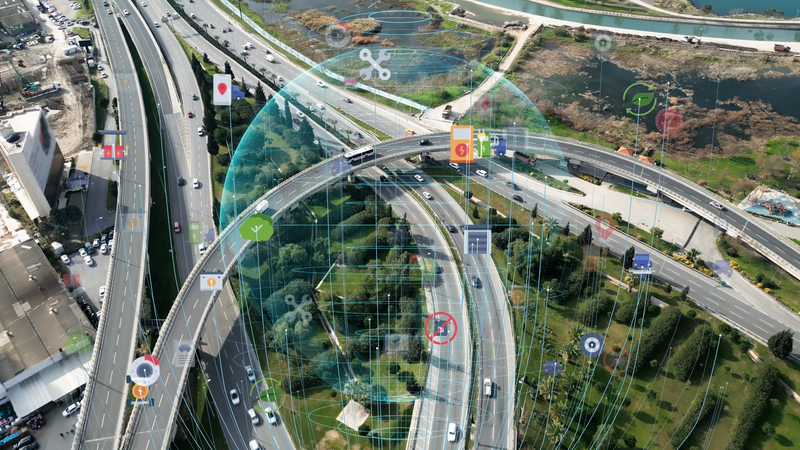

Coachella Valley in California is home to beautiful desert scenery, is the location of one of the world’s best-known music festivals – and is also the nexus of some very busy roads.
But the latter part is changing, thanks to the introduction of a highly-ambitious regional transportation infrastructure and technology project. CV Sync, led by the Coachella Valley Association of Governments (CVAG), aims to develop Coachella Valley as one of the largest smart regions in the country to improve transportation efficiency, cut traffic jams, boost road safety, enhance emergency preparedness and elevate environmental sustainability. Quite a task, in other words.
Phase I of the mammoth project commenced in April 2021 - spanning three major regional roadways: Highway 111, Ramon Road and Washington Street - and was completed in June 2023. Phase II began in February 2023 and will conclude around November 2025. Phase III is currently under design.
Coordination and collaboration are at the heart of CV Sync. “The effort extends beyond the traditional Smart City concept, focusing on the developing multi-jurisdictional smart intersections, smart corridors, and a robust broadband communication network across the region,” explains Carlos A. Ortiz, Advantec Consulting Engineers CEO and consultant programme manager. “The primary goal of the project is to enhance the quality of life for residents and visitors by reducing congestion and minimising the adverse impacts of traffic throughout the Coachella Valley.”
‘Smart region’ focus
With its focus on creating a smart region equipped to integrate current and emerging multimodal transportation systems - as well as new technologies and smart mobility solutions - there is a huge number of moving parts at play: CV Sync requires the integration of hundreds of key transport elements, with transportation engineers and construction teams leveraging advanced ITS technology to drive development and implementation.
“This project upgrades legacy traffic signal controllers, traffic management systems and communication networks to enable inter-agency traffic signal synchronisation across the region,” says Ortiz.
Advantec was chosen by CVAG in August 2015 to provide planning, design, construction support, and development of signal timing and synchronisation plans for the project. The company developed the Regionwide ITS/Smart Region Master Plan, a tool that helps prepare CVAG and local agencies for emerging transportation technologies.
The company has designed a regionwide digital infrastructure, preparing final bid documents for Phases I and II that included 24 major corridors, over 420 signalised intersections, more than 12,000 ITS elements and 21 software with cybersecurity and cloud services. ITS elements consist of open architecture and state-of-the-art 2070 and Nema ATC units with application programming interface, openly sharing management information bases at no cost to CVAG.
There are also smart CCTV systems with analytics, cellular Vehicle to Everything (C-V2X) roadside units (RSUs), arterial performance measurement systems, changeable message signs (CMS), video/radar detection systems, weather sensors and secured ethernet fibre optic communications.
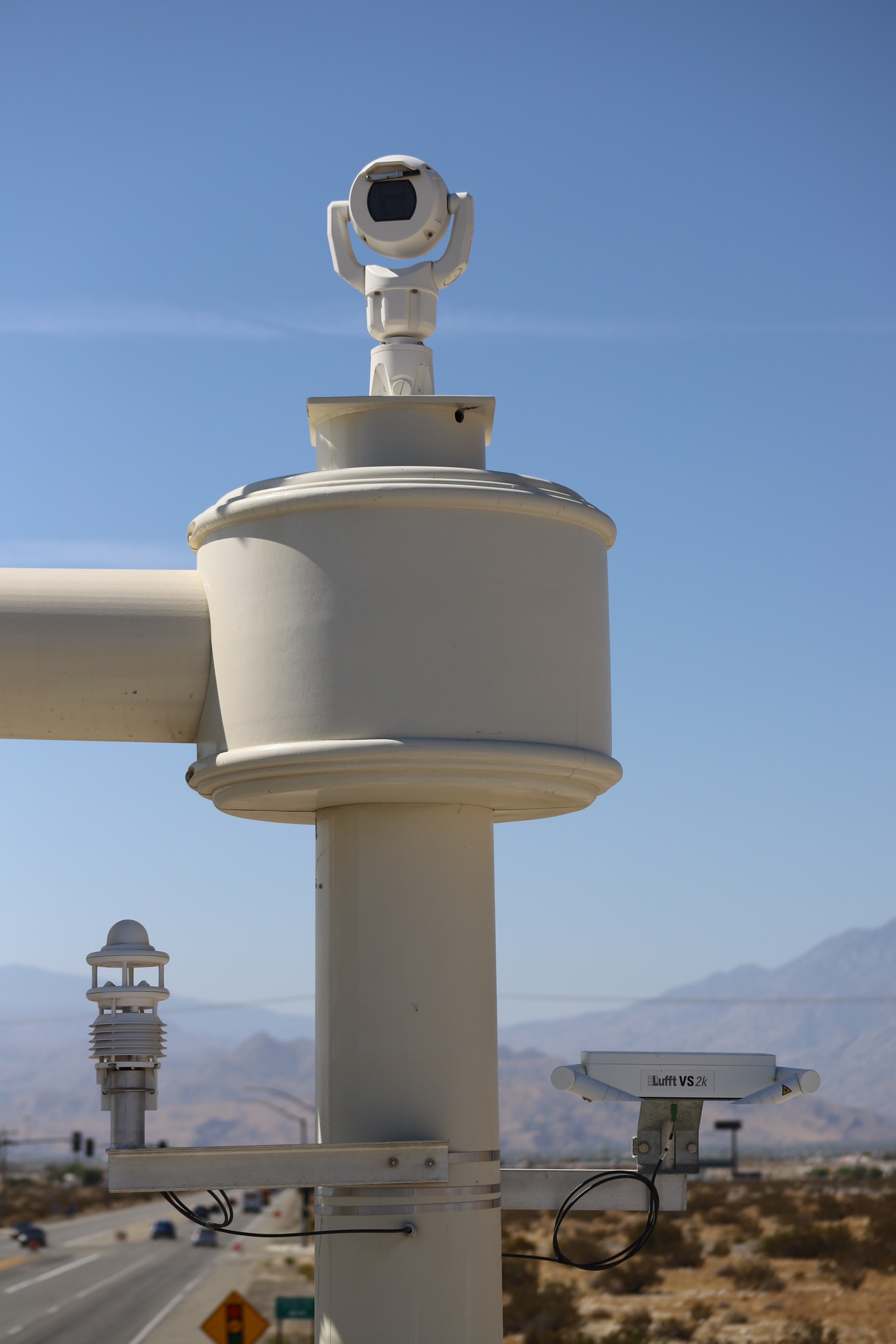
Phase III includes three corridors and 27 signalised intersections, and connectivity to Tribal Nations facilities, and to Acrisure Arena, the multi-purpose indoor venue in Palm Desert. Advantec is also supporting CVAG on its implementation of broadband communications in the Coachella Valley.

"Connecting this many agencies in a region has never been attempted and we're excited to have a major role in something that could set a standard for years to come”
Whitney Nottage, Q-Free
“CV Sync is a prime example of applying innovative concepts to address transportation challenges,” says Ortiz. “The project features advanced technologies such as connected and automated vehicles, Big Data analytics, integrated corridor management, and Smart Cities initiatives. The implementation includes a complex network of nine traffic operation centres (TOCs) and one regional traffic management centre (RTMC), equipped with CCTV systems, Bluetooth/WiFi arterial management systems and enhanced detection systems for vehicles, pedestrians and cyclists. This innovative approach minimises the need for extensive roadway construction, focusing instead on leveraging technology to improve traffic flow and safety.”
Key players
CVAG and Advantec formed a Transportation Systems Management and Operations (TSM&O) working group formed of CVAG staff, and county and cities employees, to provide education materials, facilitate project delivery, approval of regionwide technology standards, and development of the cooperative agreement.
CT West and Q-Free are two more key players in CV Sync. During the head-to-head technology assessment pilot project with other manufacturers, they were chosen as the sole provider of the STMP, R-ATMS, L-ATMS, ATC traffic controllers and Maxtime ic local controller software. CT West’s technical support team provided the timing conversions and on-site support for the ATC controllers. Currently, there are 372 signalised intersections deployed, or scheduled to be deployed, with the Q-Free ATC 2070LX or XN controllers during Phase I and Phase II.
“Q-Free has been a key technology partner and traffic software provider of choice on the project since the pilot in 2019,” says Whitney Nottage, senior EVP of operations, traffic management COO, Q-Free America. “Each of the nine participating agencies in the ‘smart region’ use our traffic signal controllers (2070LX, XN-1, and XN-2 controllers) and intersection control software (Maxtime ic) at the edge. In addition, each agency has the signal module of our Kinetic Mobility ATMS platform, Kinetic Signals, for the remote monitoring, control, and management of their traffic signal network.”
CVAG can connect to each agency’s Kinetic Signals system using centre-to-centre (C2C) communications enabled by their own deployment of Kinetic Mobility. CVAG has acquired several additional Kinetic Mobility modules in addition to signal management to allow for robust coordination of the region’s traffic network.
These additional modules and functions include:
• Events – detect, manage and respond to incidents or planned events
• Signs – centralise sign control management and messaging
• Video – end-to-end video management for improved situational awareness
• Travel time – view historical and real-time traffic data for journey times
• Counts – vehicle counts and classifications
• Corridors – automate corridor management and unify corridor-wide device control
Q-Free has supplied over 150 traffic signal controllers with another 350 more to be deployed over the next year, and 700 anticipated overall. The system aims to incorporate 132 signs, nearly 300 count stations, 12 weather stations, over 650 cameras, more than 350 travel time end points and 275 RSUs.
“Connecting this many agencies in a region has never been attempted and we're excited to have a major role in something that could set a standard for years to come,” enthuses Nottage. “The unique architecture includes a hub-and-spoke C2C connection to the eight local agency systems to pull both local and regional assets into the regional TMC, providing the local agencies control over their signals for day-to-day operations while supplying the regional TMC with a comprehensive roadway ATMS across all arterials and freeways for roadway operations during regionally significant events.”

Open standards and interoperability
Q-Free has worked with the various vendors across the region to integrate all the devices and systems into the Kinetic Mobility platform. “This includes various sign, camera, travel time, signal vendors and more,” Nottage says. “The project is a true testament to the power of collaboration, open standards and interoperability within our industry.”
There are yet more links in the CV Sync chain, explains Bill Brown, executive vice president of CT Group. “As the supplier of the STMP, R-ATMS, L-ATMS, and ATC controllers, CT West has worked closely with Crosstown Electrical & Data [prime contractor] and system integrator IndustrialEnet [iEnet] as well as all suppliers of ITS elements on the project. CT West is in the unique position of coordinating the implementation of the Q-Free Kinetic Mobility package with the other suppliers to make sure that project goals are met.”
Joseph P. Meidl, senior project manager with Crosstown, prime contractor of CV Sync, points out that the project covers major roadway corridors in an area of 675 square miles (1,728km). In additional to managing its own crews over that distance, Crosstown manages eight subcontractors and integrators – as well as iEnet and CT West, these are: MSL Electric, Ferreria Construction, Western Systems, Irvine Global Consulting, Iteris, Ontrack Scheduling and Maneri Traffic Control.
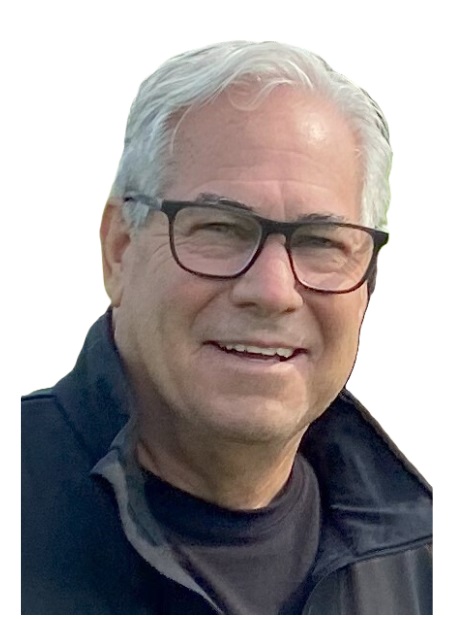
"The field crews are completing their craft work in a high-quality manner; some days they experience temperatures up to 115 degrees F” Joseph P. Meidl, Crosstown
Crosstown manages, coordinates, and performs infrastructure construction (conduit, pull boxes), roadway and sidewalk restoration, installation of fibre optic and data cables, plus installation of Ethernet switches, traffic signal controllers, edge devices (such as CCTV cameras, C-V2X RSUs and changeable message signage). TMC and TOC construction and integration consists of Ethernet network hardware and software, such as Ethernet switches, servers, communication conversion devices, workstations and video walls.
Seamless connections
“The C-V2X connected vehicle system introduces smart road technology for the future,” says Meidl. “The installed RSUs seamlessly connect vehicles to the infrastructure, playing a role in alleviating traffic congestion.”
The fibre optic cable and radio backbone interconnects eight cities: Palm Springs, Cathedral City, Palm Desert, Indian Wells, La Quinta, Indio, Coachella and Desert Hot Springs. Two agencies are remotely connected (Caltrans and the County of Riverside). At each of the TOC facilities, operators or traffic signal technicians have the ability to monitor the entire Coachella Valley and perform traffic signal changes in their respective jurisdiction.
To put all this in place can be hot work. “The field crews are completing their craft work in a high-quality manner,” Meidl says with pride. “Some days they experience temperatures up to 115 degrees F.”
Bryan Vinson, director of operations at iEnet, takes up the story: “We have worked with the designer and stakeholders to develop a scope and comprehensive technology commissioning, integration and testing plan for critical technologies along the corridor.” The company has also held the role of technology integration management for the entire CV Sync project, Vinson adds (see box The technology of CV Sync).
What does CV Sync mean for road users?
The Coachella Valley is a vibrant location that hosts numerous large-scale events, such as the Ironman Triathlon, BNP Paribas Open (tennis), Coachella Music and Art Festival, Coachella Stagecoach Country Music Festival and Desert Classic Golf Tournaments - thus attracting hundreds of thousands of visitors. The CV Sync project is a multi-faceted initiative that combines various innovative concepts, including the installation of a secure communication network, CCTV cameras, variable message signs, advanced traffic signal controllers, C-V2X RSUs, and video detection systems. Yet while the technology described so far is very interesting, ITS is focused on outcomes - so how will all this hard work by various companies and agencies help the road users of CVAG’s Smart Traffic Region?
“The benefits to end users on the road from a project like CV Sync will include greatly improved travel efficiency and safety through enhanced signal timing, video analytics, connected vehicle applications, and coordinated centralised control for events such as Coachella,” says iEnet’s Vinson. “In short, the local residents as well as the abundant visitors will be able to travel throughout the Coachella Valley as quickly and safely as possible.”
Now that the technology is deployed, the options are endless, says Mindy Gillespie, head of communications – North America at Yunex Traffic: “Of course there will be accurate travel time, but the project can also deploy pedestrian safety applications, wrong-way driver alerts, red-light runner alerts and so much more.”
For Carlos A. Ortiz of Advantec, CV Sync has already had a profound impact on transportation in the Coachella Valley. “By synchronising signals across interconnected roadway networks spanning multiple jurisdictions, the project has reduced traffic congestion, travel delays and greenhouse gas emissions,” he begins. “Real-time communication between traffic signals, connected vehicles and TMCs allows for more efficient traffic flow management, particularly during regional events and emergencies. Additionally, the project has enhanced goods movement and improved the overall quality of life for residents and visitors.”
One of the largest project challenges has been the many jurisdictional boundaries and differing systems within this large, multi-jurisdictional area. To resolve this and better work with all agencies involved, CVAG and participating stakeholders developed and approved a participating agreement to develop valley-wide ITS technology standards, synchronise major corridors, and procure, install, manage, operate and maintain the ITS infrastructure.
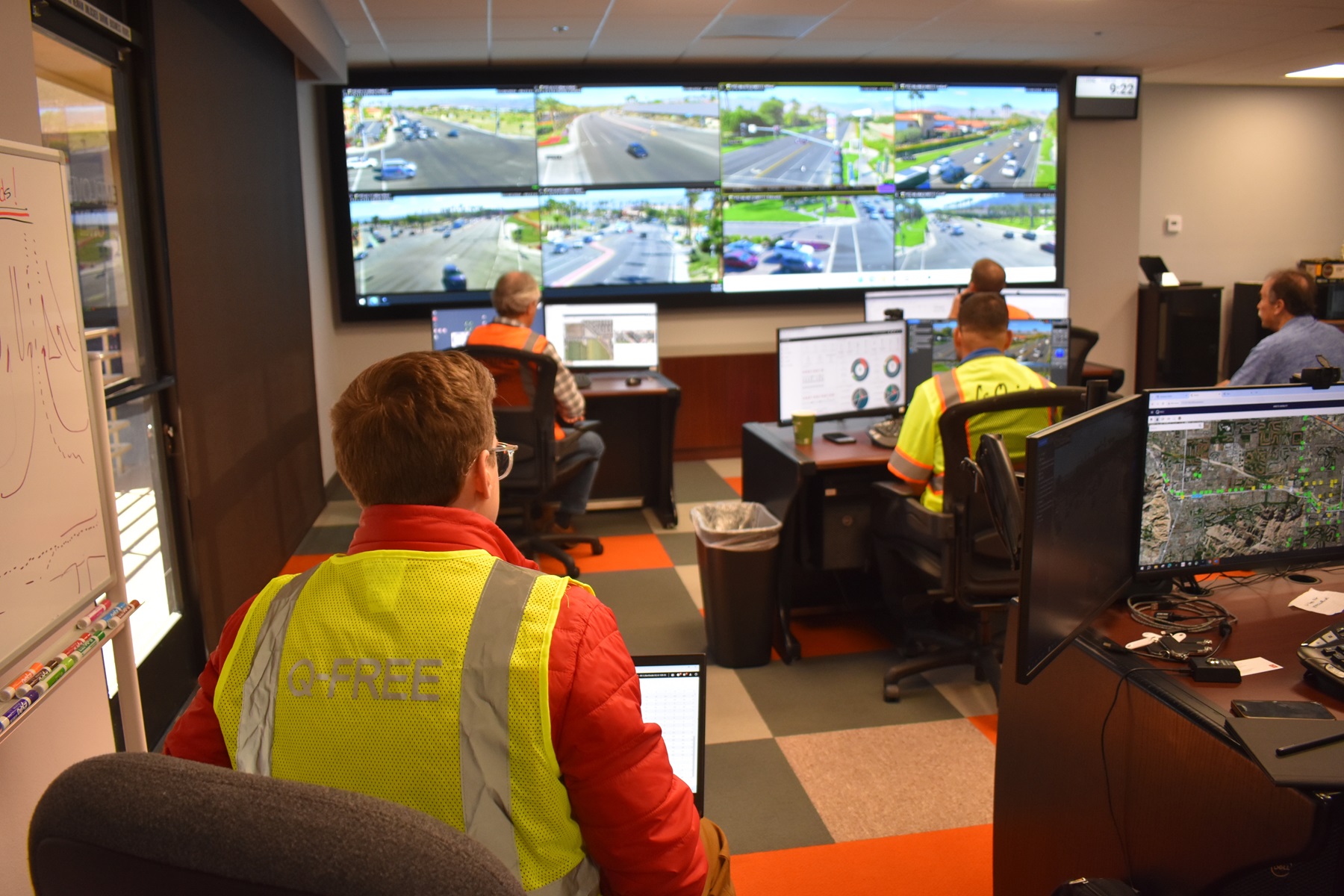
Jurisdictional boundaries
“The project has redefined current engineering thinking by using technology to solve traffic challenges rather than more lanes, and other on-the-ground solutions,” Ortiz says. “The Phase I Project has brought the Coachella Valley to the 21st century using ITS, smart transportation technologies, and innovative solutions to improve mobility, travel times, safety, and reduce greenhouse gases in the valley. The project improvements will support agencies to manage recurrence and non-recurrence events in real-time for the betterment of our communities.”
Prior to CV Sync, road users often faced inconsistent travel conditions as they moved through different jurisdictions managed by various infrastructure owners and operators, points out Whitney Nottage of Q-Free. “This lack of coordination could lead to unpredictable traffic patterns, congestion and longer travel times,” she says. “Our work on the CV Sync project introduces a centralised system, Kinetic Mobility, that fosters regional collaboration, allowing for seamless traffic management across the entire Coachella Valley. This means that drivers can now enjoy consistent roadway operations, resulting in smoother travel and enhanced safety throughout their journey. Additionally, the system’s regional approach is crucial for managing the massive influx of visitors during major events, significantly reducing congestion and travel times while improving overall safety. As the system is fully utilised, further benefits will include transit signal priority to enhance public transportation, emergency vehicle pre-emption to cut response times, and automated event management to streamline operations during significant events.”

“Everyone has the same goal in mind and, as a result, working together is more productive and less stressful” Bill Brown, CT West
Changes to traffic timing during high-profile events can be made from CVAG’s TMC in Palm Desert, where staff actively monitor and modify the entire Valley’s intersections on the system, optimising vehicle flow. “The system also allows far adapting to seasonal traffic changes,” says Joseph P. Meidl from Crosstown. “From October to March the valley’s population increases considerably due to the exceptional weather and activities available. The temporary residents, known as ‘Snowbirds’, recognise and appreciate the ease in commuting.”
Facilitating a shorter travel time from point A to point B also has environmental benefits, not least in cutting emissions. “The Coachella Valley is a dry desert area where emissions tend to stay suspended in the air,” says CT Group’s Bill Brown. “Reducing emissions will help improve air quality for the citizens and visitors of the region. One of the other advantages the road users will benefit from, but not necessarily notice, is the cross-jurisdictional cooperation of the participating agencies, which allows traffic flow to be coordinated across city lines. The ability of each agency to have access to the valley’s traffic flow data is essential to the success of this project.”
A ‘transformational’ project
It is precisely this level of cooperation which leads CV Sync to be often described as a “transformational” project. For Iouri Nemirovski, US field device product manager at Yunex Traffic, it “is transformational in the sense that it breaches a gap …by meeting today’s needs and providing long term future-proof solution”.
The sheer number of local authorities and agencies involved is another reason. “The project is unique in the sense that it incorporates numerous technologies, which when combined create the ideal technically ‘driven’ corridor,” says Meidl. “The number of intersections integrated and synchronised makes it special – eight cities under control.”
It is truly “one-of-a-kind in the ITS world”, thinks Bryan Vinson at iEnet – and CV Sync’s legacy may be considerable: “[It] is proving to be transformative in the way it has been successful at a deployment level but has also begun to influence similar ‘CV Sync-like’ projects in scale, budget and technology design and aspirations.”
Indeed, this type of regional project is essentially the foundation for future synchronisation projects that employ agency-to-agency, agency-to-region and C-V2X elements, both nationally and globally, believes Brown. “Without cross-jurisdictional cooperation, the connected and autonomous vehicle (C/AV) technologies cannot become reality,” he says. “The infrastructure needs to be seamless for the road user. This project demonstrates that seamlessness and is, therefore, being viewed across North America as a benchmark for future RTSSPs [regional traffic signal synchronisation programmes]. CV Sync proves that the future can become a reality.”
Advantec’s Ortiz adds: “These technologies provide real-time traffic surveillance, data collection and system performance monitoring, enabling agencies to manage traffic effectively and improve mobility along major corridors. CV Sync is using the application of innovative engineering technology to meet the challenges of traffic congestion, safety and sustainability.”
‘Future-proofing’
The investment in ITS technology also has a ‘future-proofing’ element to it too, Ortiz continues, “to prepare the region for integration of current and upcoming multimodal transportation technologies, and smart mobility programmes”.
The project’s solutions have improved traffic flows, emergency response and large-scale event management, all while reducing congestion and environmental impact, he adds. And the new, secured fibre optic network will also support future public-private broadband communications, extending benefits to low-income communities and tribal lands.
“These innovations enhance safety, security and quality of life while improving transportation for a diverse range of users. By utilising advanced technology rather than disruptive pavement construction, CV Sync has achieved significant cost savings and responsible use of public funds,” Ortiz concludes.
“The CV Sync project is groundbreaking because it brings together 10 different infrastructure owners and operators (IOOs) – nine participating agencies plus Caltrans – to collaborate on a unified transportation solution, a feat rarely achieved in the industry,” says Q-Free’s Nottage. “The fact that these agencies not only agreed to work together but also implemented a cohesive system that benefits the entire travelling public is truly transformational. What sets this project apart even further is its implementation: no other system in the country offers C2C operations across eight agencies within a single region, integrating both arterial and freeway management into one advanced ATMS platform. This level of regional collaboration and technical integration is unparalleled, making CV Sync a model for future smart traffic systems nationwide.”
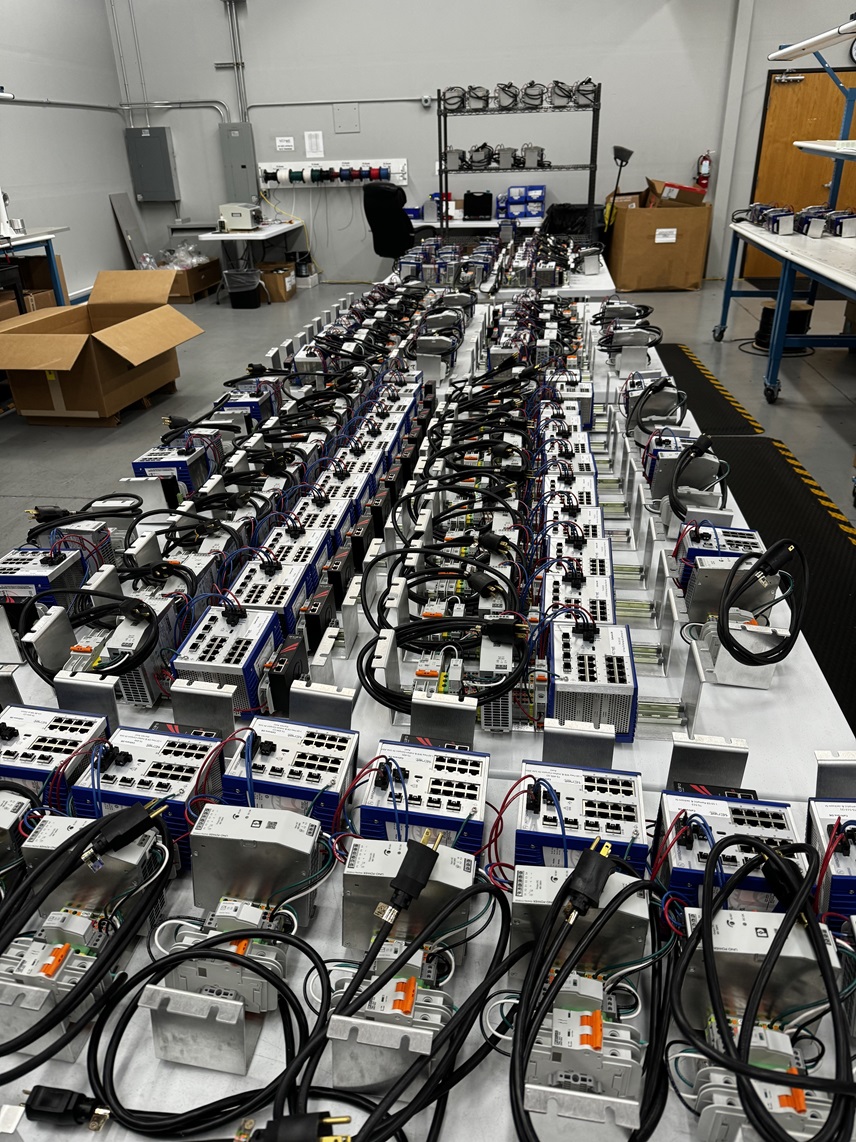
Importance of collaboration
With 17 agencies and entities, including local governments, Tribal Nations, and federal and state transportation authorities, involved, collaboration has also been a key feature of CV Sync. “Absolutely,” Nottage continues. “Q-Free’s Kinetic Mobility platform was specifically designed to facilitate collaboration. We’ve observed a significant industry shift from traditionally separate freeway and signal operations to a more integrated, collaborative approach. Anticipating this change, we began developing Kinetic Mobility four years ago to support and drive this evolution. By consolidating freeway and signal operations into a single application and enabling robust C2C architecture, Kinetic Mobility empowers operational divisions and agencies to work together more effectively in managing transportation systems.”
Mindy Gillespie, Yunex head of communications – North America, says: “It is often not easy to bring together multiple agencies, and vendors into one project. Without collaboration the project would not be nearly as impactful. It also shows how interoperability can play a key role, not just in the technology but with all the stakeholders as well.”
“We have most definitely seen collaboration between the agencies, suppliers, and consultants,” confirms Brown. “As the main system on-site commissioner, we have worked with all the participating agencies and suppliers. Everyone has the same goal in mind and, as a result, working together is more productive and less stressful.” Prime contractor Crosstown Electrical & Data “has done a fantastic job of keeping every element of the project moving forward, ensuring success”.
Crosstown’s Joseph P. Meidl says: “Collaboration begins with the entire project having been organised by CVAG bringing each city to the programme, securing numerous funding sources and in cooperation with the state and federal governments. From concept to design to deployment, this project required and received a commitment from all involved.”

“Success on a project like this is not static but ongoing as we conquer each new technology hurdle and continue to add resources” Bryan Vinson, iEnet
A project the size and scale of CV Sync, with dozens of technologies and thousands of field elements deployed in public roadways across 12 cities and municipalities, is a challenge on multiple levels. “One of the fundamental challenges is delivering all equipment, software and related services at scale in a manner that is cohesive and aligned with contract expectations across multiple technology vendors,” says Bryan Vinson of iEnet. The company’s technology integration management role for the CV Sync project gives it responsibilities for leading weekly integration meetings, peer vendor collaboration and reviews and overall technology integration management to ensure project submittals, design documentation, schedules, RFIs, engineering requests, project changes, commissioning and testing procedures are coordinated, reviewed and approved as a team.
“[We need to] avoid disparate vendor procedures and practices to avoid project delays and keep the project on time and on target,” Vinson notes.
Looking to the future
The consensus of opinion among the engineers involved in CV Sync is that similar projects will definitely be seen across the US in the coming years.
For Advantec’s Carlos A. Ortiz, the project has been a significant milestone. “CV Sync has disrupted our transportation industry by championing open architecture applications and shifting focus from investing in R&D for regional-specific needs,” he suggests. “I hope that agencies move away from legacy and proprietary technologies. We need to engage technology partners (e.g. Q-Free, Bosch and others) to align with each agency’s smart region vision and provide support not only during deployment but also throughout the programmes’ operations, management and maintenance.”
In the Coachella Valley network, technology has been applied to improve safety, security, quality of life and overall transportation for a diversity of users.
Ortiz highlights again the innovative use of engineering technology, including that complex network of nine TOCs, one regional TMC, C-V2X tech, Big Data, smart intersections and corridors, cybersecurity and Smart Cities initiatives. “This project is one of the largest smart region projects in the US and is being used as an example all over the world due to its social impact of reduced congestion, reduced travel time, improved air quality, managed emergencies, managed events, increased quality of life in the regions targeted and better, controlled management to transportation engineering, while also implementing sustainable practices in transportation,” he adds. “A key to success in this or similar deployments, is developing a partnering agreement between participating agencies to allocate funding for planning, design, construction, operations, management and maintenance.”
“The demand is clear,” says Nottage. “Throughout 2023 and 2024, we've seen several requests for systems that integrate signal and freeway operations and support the kind of C2C architectures demonstrated by the CV Sync project. We’re actively engaging with both current and potential customers to showcase the success of CV Sync, helping them shift mindsets, foster collaboration, and unite willing partners in the shared mission of improving mobility for all roadway users. Success with CV Sync will be measured by the increased efficiency, safety and seamless travel experiences for the public, setting a benchmark for future projects.”
Bryan Vinson of iEnet is certain that more CV Sync-type projects will be seen “both throughout California as well as across the US in the very near future”. He adds: “As CV Sync continues deployment of technologies in Phase II and prepares for the next phase soon, these current systems are up and operational with nothing but improvements and enhanced operability on the horizon. Success on a project like this is not static but ongoing as we conquer each new technology hurdle and continue to add resources and improve user experience and overall project value.”
These types of projects are most certainly going to continue to be designed and deployed in the future, agrees Bill Brown at CT Group: “I am aware of a few RTSSPs in the early stages of development and assessment of the technologies currently available,” he says. “As this project progresses, other municipal planning organisations are keeping a close eye on this project and are reaching out to the CVAG staff for information and lessons learned so that, as they develop their Smart Signal Regional Plan, they are using real-life, usable data.”
As far as quantifying the success of CV Sync, he says that during the last round of major events in the region – such as Stagecoach, Coachella and Ironman - the communication with road users via DMS signs, as well as the implementation of special event timing, helped make the ingress and egress of traffic much smoother than ever before. “This alone demonstrates great project success,” Brown points out. “Additionally, as more ITS elements are deployed, the system will continue to see more and more success.”
So who’s up for Coachella 2025?
We’ve left the biggest, most important question until last: Lana del Ray and Doja Cat were among the headliners at Coachella 2024 - so are the engineers planning to let their hair down and strut their stuff at Coachella 2025 with Billie Eilish, SZA, or whoever else is currently predicted to perform?

“Team Yunex Traffic wouldn’t miss it!” says Gillespie. At Crosstown Electrical & Data, Meidl is not so sure: “Probably not (again). We talk about it every year, but never get around to making it happen. Maybe I’ll drive by!”
Currently, Advantec is designing a TOC for Goldenvoice, the promoter responsible for events such as the Coachella Music & Arts Festivals and Stagecoach, to support management of special events at the Empire Polo Fields, so Ortiz says he is hoping to be there.
The last word goes to Whitney Nottage at Q-Free, who demonstrates her commitment to both music and her work. “I anticipate being in the CVAG region for Coachella in 2025,” she predicts. “Though I might be there more in a work capacity - helping CVAG manage the intricate event planning and traffic operations that ensure everyone gets to the festival safely and efficiently. If I’m lucky, I might catch a concert or two, but honestly, as a ‘traffic enginerd’, being in the ‘war room’ orchestrating the flow of thousands of people will be the real headliner for me.”
Thanks to the work of these traffic engineers and their enterprising companies, revellers and festival goers may find their route smooth and their way surprisingly clear to the Empire Polo Club in Indio, next April. Not that they’ll know why. But we’ll know.
----------------------------------------------------------------------------------------------------
How CV Sync has already been working

CV Sync’s technologies and tools have already been implemented at major events in the Coachella Valley, explains Carlos A. Ortiz of Advantec…
City of La Quinta 2022 and 2023 Ironman Triathlon: City staff, County of Riverside Sherriff, and Advantec staff used the Phase I ITS technologies to manage the event in real-time via the city’s remodelled TOC. Using installed CCTV cameras and advanced signal controllers meant City staff could close travel lanes and roadway segments and re-open these facilities in real time while communicating with field staff and officers.
City of Indian Wells 2023 and 2024 BNP Paribas Open: During this tennis tournament, often dubbed the ‘fifth Grand Slam’, CVAG and city staff, with support from Advantec, managed inbound and outbound traffic in real time using CCTV cameras, video detection systems and advanced traffic controllers from the RTMC. It allowed staff to be able to change signal timing to minimise delays and impacts as vehicles and buses were entering the Indian Wells Tennis Garden - and allowed staff to do the same to flush out traffic at the end of the last evening tennis match.
The technology of CV Sync
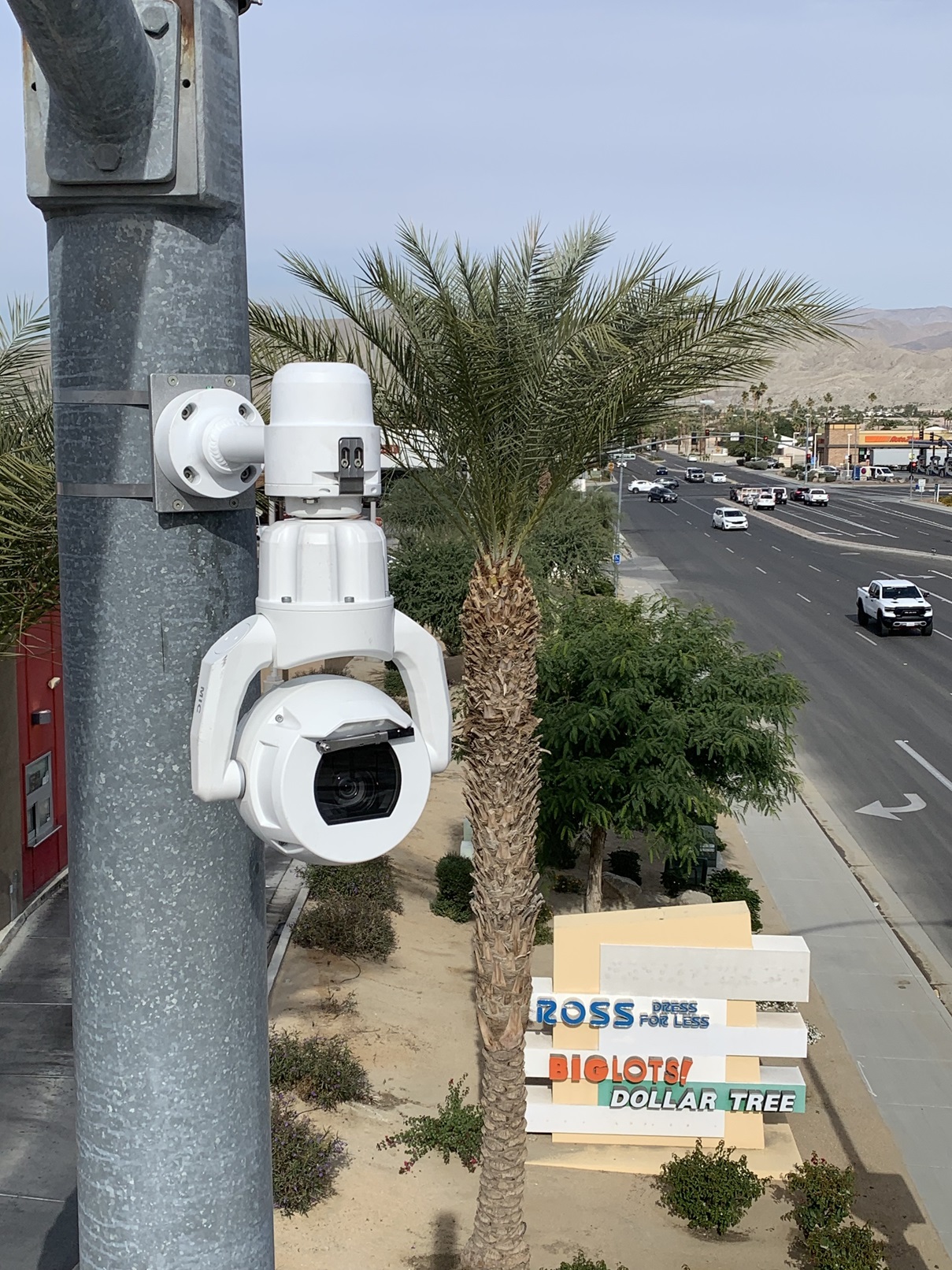
There are a plethora of critical technologies in the CV Sync corridor, explains Bryan Vinson, director of operations at iEnet. These include Bosch IP cameras, Genetec Video Management System (VMS), Belden Hirschmann Layer 2 Network Switches and Layer 3 Hub Switches, Cisco Layer 3 Core Switches and VPN Firewall Appliances, Belden Hirschmann Network Management System (NMS), Dell System workstations and laptops, cybersecurity, Genetec Physical Access Control (hub cabinet smart locks) and Belden Network Access Control (NAC). The list is comprehensive: iEnet has commissioned and deployed 270 IP Cameras with ITS analytics, 440 Layer 2 Edge Switches, 55 Layer 3 Hub Switches, 20 Layer 3 Core Switches, 10 VPN Firewalls, 35 workstations and 22 ruggedised laptops, 35 Hub Cabinet Smart Locks and 30 Servers running VMS, NMS, and NAC software throughout the cities of Desert Hot Springs, Palm Springs, Cathedral City, Palm Desert, Indian Wells, La Quinta, Indio, Coachella, County of Riverside and Caltrans District 8 at traffic signal cabinets, local TOCs and the RTMC at CV Sync HQ in Palm Desert.
What the CV Sync project involves
CV Sync includes nine traffic operation centres, one regional traffic management centre, connected and automated vehicles, Big Data, integrated corridor management, Mobility as a Service, Mobility on Demand and Smart City initiatives. Advantec’s work consisted of 35 major tasks including the development of the priority corridors evaluation, system engineering management plan, concept of operations and strategic deployment plan, system requirements, environmental, preliminary engineering, technology assessment and evaluation (including ITS, C/AV, and Smart Cities), systems integrator procurement and design, system implementation, traffic signal synchronisation, operations and maintenance. Improvements include:
Secured Communication Network
RSUs/C-2VX units to provide V2I communications
Field Communication Hubs
CCTV cameras with Analytics
Changeable Message Signs
Bluetooth/Wi Fi Arterial Management Systems
Advanced Traffic Signal Controllers
Video Detection Systems
Weather Stations
VPN Connectivity to Caltrans D8
VPN Connectivity to Riverside County
Back-Up Cloud Services
Cyber Security Elements
Broadband Communications
Video Analytics
System Performance Measurements
Asset Management System







